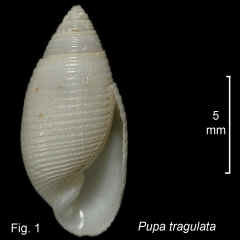|
|
ACTEONIDAE |
|
|
|
Pupa tragulata Iredale, 1936 Description: Shell pupoid in shape, relatively wide, aperture 2/3 of total shell length. Spire whorls with about 5 strong spiral cords; suture impressed. Last whorl sculptured with about 20 regularly spaced, flat-topped spiral cords, the intervening grooves always with fine axial lamellae. Aperture elongate, increasing from narrow at top to broad and rounded below; outer lip sharp, inner lip with thick white callus on previous whorl. Columella with a very strong bifid plait below a single weak plait, with a deep channel between. Colour white, covered with brown periostracum when fresh. Size: Up to 16 mm in length. Distribution:
Endemic to Habitat: Subtidal. Most specimens dredged in 60–200 m. Moderately common. Comparison: Given the variability as presently interpreted within Pupa affinis, this species might be regarded as a form of that species, but there are characters which, when grouped together, remain consistent and distinguish it as a good species. The spiral cords are regular in strength and spacing, always with fine axial lamellae in the grooves between them. The bifid plait on the columella is very strong, separated from the weak plait above by a deep channel. But most importantly, it is a subtidal species from 60–200 m while Pupa affinis lives from the lowest intertidal to the shallow subtidal. Remarks: Beu (2004, p. 220) treated this species as a synonym of Pupa affinis, but Burn (2006) maintained it as a good species, noting “slight differences in the radula support retention of tragulata as a separate deep-water species”. Fig. 1: Off Jibbon, Port Hacking, NSW, in 80 m. (C.332612). |
|
